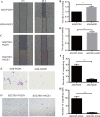Overexpression of HACE1 in gastric cancer inhibits tumor aggressiveness by impeding cell proliferation and migration
- PMID: 29673126
- PMCID: PMC6010910
- DOI: 10.1002/cam4.1496
Overexpression of HACE1 in gastric cancer inhibits tumor aggressiveness by impeding cell proliferation and migration
Abstract
HACE1 E3 ligase was discovered to be down-regulated in several cancers while its role in regulating tumors was merely understood. This study aimed to explore the specific effect of HACE1 played in gastric tumorigenesis and its potential mechanism. HACE1's expression was found significantly lower in gastric cancer tissues compared with the adjacent normal tissues (P < 0.001). Its protein level in gastric cancer negatively correlated to tumor pathological differentiation (P = 0.019). And in gastric cancer patients with TNM I-IIIa, those with lower HACE1 protein level had poorer overall survival (P = 0.025). Studies, in vivo and in vitro, showed that overexpressing HACE1 inhibited tumor proliferation and migration, and enhanced cell apoptosis. Besides, ectopic expression of HACE1 down-regulated the protein level of β-catenin and inhibited the activity of the Wnt/β-catenin signaling pathway. All the cellular functions were abolished when we overexpressed inactive HACE1-deltaHECT. Above all, we demonstrated that HACE1 E3 ligase played a suppressive role in gastric tumorigenesis and inhibited the activity of the Wnt/β-catenin signaling pathway. Circumventing the decline of HACE1 in early stage of carcinoma may impede the tumorigenesis and malignant process of gastric cancer.
Keywords: Gastric cancer; HACE1; Wnt/β-catenin pathway; migration; proliferation.
© 2018 The Authors. Cancer Medicine published by John Wiley & Sons Ltd.
Figures







References
-
- Torre, L. A. , Bray F., Siegel R. L., Ferlay J., Lortet‐Tieulent J., and Jemal A.. 2015. Global cancer statistics, 2012. CA Cancer J. Clin. 65:87–108. - PubMed
-
- Anglesio, M. S. , Evdokimova V., Melnyk N., Zhang L., Fernandez C. V., Grundy P. E., et al. 2004. Differential expression of a novel ankyrin containing E3 ubiquitin‐protein ligase, Hace1, in sporadic Wilms’ tumor versus normal kidney. Hum. Mol. Genet. 13:2061–2074. - PubMed
-
- Bouzelfen, A. , Alcantara M., Kora H., Picquenot J. M., Bertrand P., Cornic M., et al. 2016. HACE1 is a putative tumor suppressor gene in B‐cell lymphomagenesis and is down‐regulated by both deletion and epigenetic alterations. Leuk. Res. 45:90–100. - PubMed
-
- Hibi, K. , Sakata M., Sakuraba K., Shirahata A., Goto T., Mizukami H., et al. 2008. Aberrant methylation of the HACE1 gene is frequently detected in advanced colorectal cancer. Anticancer Res. 28:1581–1584. - PubMed
Publication types
MeSH terms
Substances
LinkOut - more resources
Full Text Sources
Other Literature Sources
Medical

